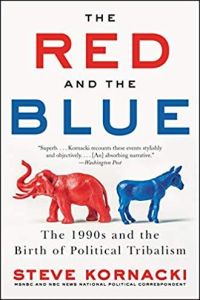Confrontation Replaces Compromise
Kornacki starts his sweeping account at the (preliminary) apex of the development he set forth to analyze: The deep divide which exists between Red America and Blue America, he holds, was encapsulated in the presidential election of 2000: a dead heat between George W. Bush and Al Gore that needed weeks to resolve. But the political tribalism, gridlock, showmanship and showdowns which have characterized Washington in the years since did not come out of nowhere. To Kornacki, it was the previous decade that set the stage: The 1990s was a comparatively tranquil era: a time of economic growth, a robust job market and rising stock prices. Technological innovation was exciting but not dizzying; social media didn’t exist. America’s military excursions abroad were short and surgical. And the media landscape looked quite different.
Yet beneath the calm, the book goes on, a new brand of politics was taking hold in Washington. The Republicans had won the White House in five of the previous six elections. The Democrats had held the House of Representatives for decades. While the parties battled, compromise was the order of the day. House Minority Leader Robert Michel, a mild-mannered Republican from Illinois, was known for seeking accommodation across the aisle. He even played golf with House Speaker Thomas Phillip “Tip” O’Neill Jr. This spirit of bipartisan cooperation would soon wither, however. The Democratic Party would win two presidential elections with a candidate and first lady despised by the right, while the Republicans would take control of the House under the leadership of a confrontational new leader, Newt Gingrich.




















Comment on this review